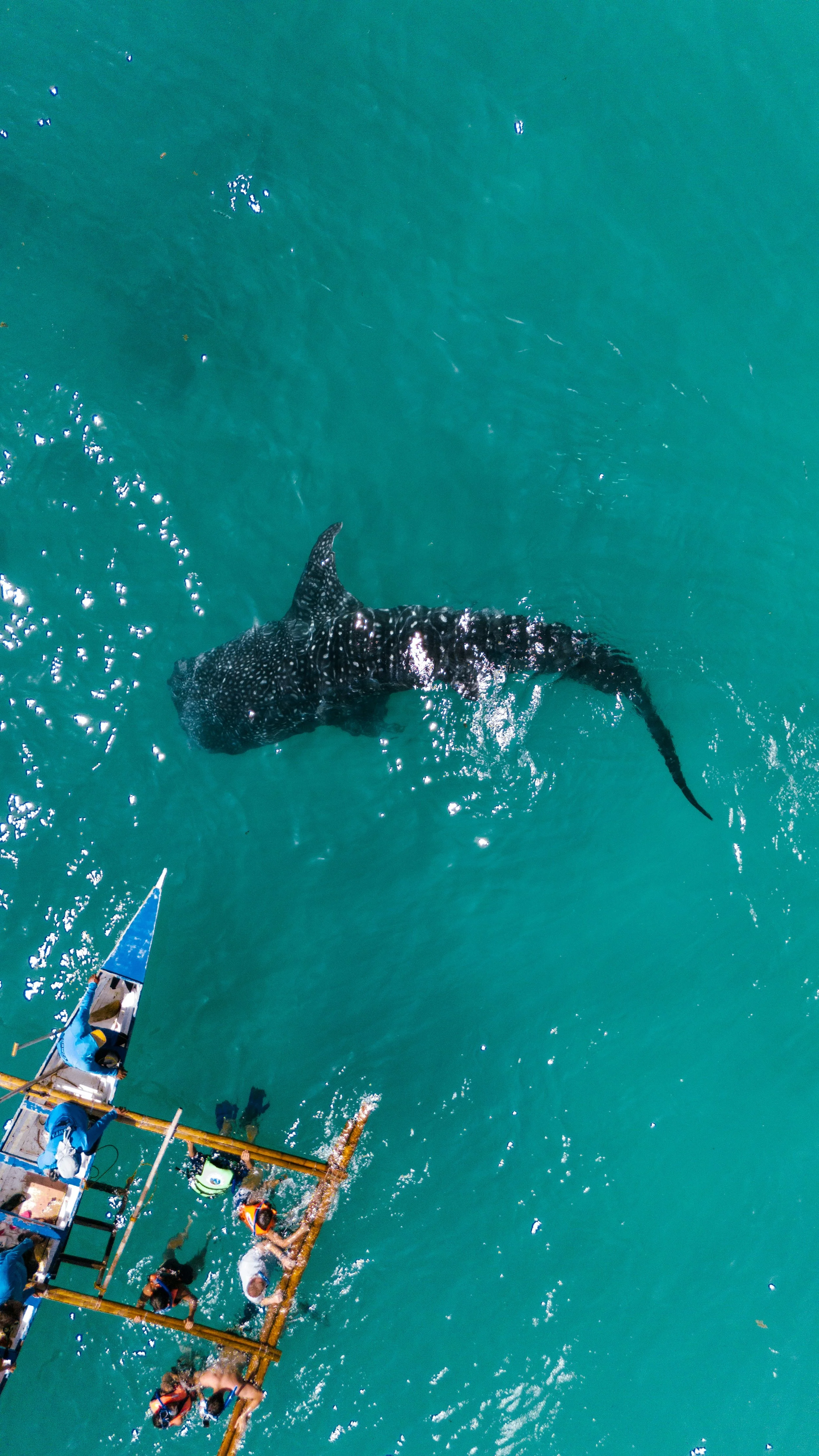The Toxic Relationship Between Fishermen and Whale sharks
If you’ve ever been interested in the ocean, you’ve probably heard about whale sharks. If you haven’t, picture this: a gentle giant, the size of a school bus, slowly making its way across the ocean. Its back is covered in white dots, like stars against a dark blue sky. Despite their large size, these creatures are completely harmless, eating primarily plankton, krill, and small fish.
Sadly, humans remain their biggest threat.
Fishing is one of the greatest dangers to whale sharks. Although illegal capture and butchering of whale sharks have become less common, they still happen in some places— sometimes intentionally, sometimes unknowingly. Whale sharks are also frequently get entangled in abandoned fishing gear or caught as bycatch.
Even though there are rules and laws meant to protect these gentle giants, enforcement is often weak or inconsistent. I believe this lack of regulation and awareness leads many people to ignore these protections, putting whale sharks at continued risk.
Targeted Captures
Whale Sharks are most directly targeted in Iran, Pakistan, the Maldives, Indonesia, and the Philipines with most large-scale operations ocurring in China, India, and Taiwan. Like I said before, with new rules and regulations, intentional captures aren’t as common anymore and don’t pose as big as an issue as bycatch— but are still a recurrent issue.
Traditional fishing boat on Pemuteran Beach, a coastal village in northwestern Bali, Indonesia.
By Hello World Via Unsplash
Indonesia
In Indonesia, for example, locals routinley cut, sell, and eat beached whale sharks. The profits often go towards funding community or local projects.
Most of the time, people in places like Java, Indonesia don’t kill whale sharks out of malicious intent—it’s usually out of opportunity or simply a lack of knowledge that the species is protected. While there are laws in Indonesia that prohibit the capture and harvest of whale sharks, they aren’t consistently enforced or widely advertised. As a result, many people either don’t see an issue with it or don’t even know the laws exist.
A study conducted in Pangandaran bay from 2002-2022 documented 16 whale sharks butchered and three confirmed sales. In total, the study recorded 31 captured whale sharks—this number includes both bycatch and intentionally captured individuals.
The same study, conducted on Java’s South Coast for a shorter period (2019–2022), found 12 whale sharks butchered and 10 returned to sea, buried, or left to wildlife. In total, the researchers documented 38 reported interactions between whale sharks and fishermen—most of which ended badly for the sharks.
Landings in Java tend to occur more often in July and October, which researchers believe is linked to whale shark migration patterns and a greater number of sharks passing through the area at those times.
While Java is not considered a major whale shark trading hub, there are still at least 11 landings per year. Many believe the true number is closer to 15–30.
Pangandaran, West Java, Indonesia
By Abdul Ridwan Via Unsplash
Although these numbers may seem small, they reflect the local perception of whale sharks. Many fishermen view them as “large” and “stupid” because they often damage fishing nets. At the same time, whale sharks are seen as a good omen, with landings believed to bring good luck and prosperous times ahead. These beliefs lead some Indonesian fishermen to blame the sharks for being “stupid” when they become entangled in nets—and others even hope the animals will get caught to bring them luck.
This theory was proven when some researchers started a campaign to spread awareness about these whale sharks. In that town, locals began to free whale sharks due to their newfound respect for them. This happened in the costal towns of Veraval and Ahmedabad, both of which used to be very prominent whale shark trading hubs. This leads me to belive that, with more awareness and importance set on these creatures, people will be less inclined to go after them.
China and Taiwan: Global Trading Hubs
China, however, is a very large whale shark —and shark in general— trading hub, with Hong Kong being the largest in the world for shark fins. Large shipments of these fins are labeled as “dried seafood” so they don’t raise any alarms and many do end up going undetected. Those that are caught are often found to contain whale shark fins along with those of many other endangered and protected shark species.
There is a slaughterhouse in China, specializing in selling shark fins, that specifically targeted whale sharks and many other sharks that are also illegal to capture or kill. Some of the other sharks found were great white sharks and basking sharks— both of which are protected by law in China. These laws can result in jail time and substantial fines, with some cases reporting jail time of over 10 years and fines upwards of $20,000. The laws in China are strictly enforced, unlike that of Indonesia, with a Chinese food blogger being fined for purchasing and eating great white shark.
Shark fin trading in Chinatown, Singapore.
By Naja Bertolt Jensen Via Unsplash
Taiwan is also a large shark fin hub and provides many of their fins to China. However, in 2004, there was a large discrepancy surrounding the less popular whale shark meat trade. There were 32.5 tons obtained from legal harvests, while 68.5 tons of meat were actually sold. Those numbers mean that 36 tons of whale shark meat were either illegally harvested, unreported, or unknowingly shipped from some place else.
Habitat Degregation
Another very prominent threat to whale sharks is habitat degregation through fishing methods or gear. Abandoned fishing gear causes the open ocean that these sharks reside in to become more and more polluted. Between 500,000 and 1,000,000 tons of abandoned fishing gear enter the ocean every single year. This damages coral, vegetation, causes sediment buildup, and impacts access to key ecosystems all which diminish the abundance of prey. This abandoned gear is termed “ghost gear.” Whale sharks can easily become entangled in ghost gear which can lead to limited movement, or even death if they aren’t able to swim freely.
A diver clears rope from entangling an endangered Elkhorn coral.
By Karl Callwood Via Unsplash
Fishing methods such as bottom trawling also leads to the decline of the health of the ecosystem these sharks rely on. Botton trawling is when a large net is taken and scraped along the surface floor, catching anything and everything in its way while simultaneously destroying the sea floor as it scrapes across. This method of fishing destroys sea floor habitats which disrupts the food chain and leads to a lack of food for the whale sharks since these smaller fish rely on these habitats.
Bycatch: the Biggest Threat
While targeted captures seem to be more of a social issue, bycatch is not and is one of the most prominent causes of whale shark deaths. This is because of the whale shark’s strong assosiation with Tuna. You may be asking yourself, “What do whale sharks and tuna have to do with each other?” Well, they actually have a mutualistic relationship. Whale sharks usually have to filter feed on the surface of the water because they are extremley slow, moving at around 3 miles per hour. But, when the quick tuna are present, they are able to “herd” the baitfish so that the whale sharks can consume them— since the fish would otherwise be way too fast for the sharks.
Many fishermen have been reported intentionally capturing whale sharks in order to increase their tuna harvests. This happens because they are often found in close proximity to each other and it’s easier to catch the whale sharks along with the tuna, rather than try to work around them or wait for them to move out of the way. This is the reason why these sharks are seen as a nusiance to many commercial fishermen. Satelite tagging in the Galapagos proves this frequent interactions between whale sharks and fishermen.
Bluefin Tuna breaching in Torbay, Devon
By Ray Harrington Via Unsplash
Bycatch poses such a threat to whale sharks because of the sheer number of them being caught— more than 1,000 every year! Even when they are released, the stress of being ensnared in the nets usually leads to harm and, in many cases, death.
Why This Matters
The whale shark population has declined by more than 50% in the last 75 years— and it’s mostly because of us. Fishing-related incidents remain the largest threat to these gentle giants. But this decline isn’t inevitable. With more awareness, education, and empathy, we can stop the harm before it happens.
Whale sharks are some of the most magnificent creatures in the ocean. They deserve not just protection, but recognition as a species worth fighting for. To truly make a difference, I believe we have to stop generalizing and start getting personal— focusing not just on the shark fin trade, but on individual species like the whale shark that are slipping away quietly.
Much of their decline isn’t even intentional. That means it can be reversed if people understand these animals, their behaviors, and their role in the ecosystem. Change begins when we shift our view from “stupid animal” to “beautiful creature.” That shift is what turns laws into values. It’s what turns compliance into compassion.
I firmly believe that change begins inside of our hearts, you just have to believe the message first.
Whale Shark swimming around people in Oslob, Cebu, Philippines
By Mounish Raja Via Unsplash
Sources
Mongabay. (2023). Indonesia faces scrutiny over whale shark fishing despite protected status. https://news.mongabay.com/2023/09/indonesia-whale-shark-fishing-protected-species-endangered/
Deep Sea News. (2014). Whale shark slaughterhouse exposed in China. https://deepseanews.com/2014/01/whale-shark-slaughterhouse-exposed-in-china/
Cheok, Z. X., Giam, X., et al. (2023). Mapping the global use and trade of whale sharks. PLOS One. https://pmc.ncbi.nlm.nih.gov/articles/PMC10451966/
Reuters. (2018). Endangered whale shark fins found in Singapore Airlines shipment to Hong Kong. https://www.reuters.com/article/business/environment/endangered-whale-shark-fins-found-in-singapore-airlines-shipment-to-hk-idUSKCN1IV08G/
WWF. (n.d.). Managing Taiwan’s whale shark trade. https://wwf.panda.org/es/?77100/Managing-Taiwans-whale-shark-trade
People Not Poaching. (n.d.). Whale shark conservation project. https://www.peoplenotpoaching.org/whale-shark-conservation-project
Galapagos Whale Shark Project. (n.d.). Threats & conservation status. https://www.galapagoswhaleshark.org/threats-conservation-status
Miller, T. R., et al. (2020). Whale shark–tuna associations: Insights from a small pole-and-line fishery in the mid-north Atlantic. ResearchGate. https://www.researchgate.net/publication/341300781_Whale_shark-tuna_associations_insights_from_a_small_pole-and-line_fishery_from_the_mid-north_Atlantic
Earth.Org. (n.d.). Whale sharks. https://earth.org/?endangered-species=whale-sharks
Save Our Seas Foundation. (n.d.). The sea’s sheepdogs: Tuna and whale shark feeding associations in the Azores. https://saveourseas.com/project/the-seas-sheepdogs-tuna-and-whale-shark-feeding-associations-in-the-azores/






